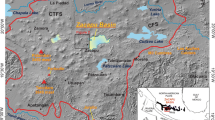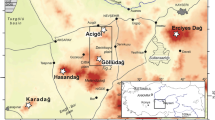Abstract
Fieldwork, radiometric (40Ar/39Ar and 14C) ages and whole-rock geochemistry allow a reconstruction of eruptive stages at the active, mainly dacitic, Pichincha Volcanic Complex (PVC), whose eruptions have repeatedly threatened Quito, most recently from 1999 to 2001. After the emplacement of basal lavas dated at ∼1100 to 900 ka, the eruptive activity of the old Rucu Pichincha volcano lasted from ∼850 ka to ∼150 ka before present (BP) and resulted in a 15 × 20 km-wide edifice, which comprises three main building stages: (1) A lower stratocone (Lower Rucu, ∼160 km3 in volume) developed from ∼850 to 600 ka; (2) This edifice was capped by a steeper-sided and less voluminous cone (the Upper Rucu, 40–50 km3), the history of which started 450–430 ka ago and ended around 250 ka with a sector collapse; (3) A smaller (8–10 km3) but more explosive edifice grew in the avalanche amphitheatre and ended Rucu Pichincha's history about 150 ka ago. The Guagua Pichincha volcano (GGP) was developed from 60 ka on the western flank of Rucu with four growth stages separated by major catastrophic events. (1) From ∼60 to 47 ka, a basal effusive stratocone developed, terminating with a large ash-and-pumice flow event. (2) This basal volcano was followed by a long-lasting dome building stage and related explosive episodes, the latter occurring between 28–30 and 22–23 ka. These first two stages formed the main GGP (∼30 km3), a large part of which was removed by a major collapse 11 ka BP. (3) Sustained explosive activity and viscous lava extrusions gave rise to a new edifice, Toaza (4–5 km3 in volume), which in turn collapsed around 4 ka BP. (4) The ensuing amphitheatre was partly filled by the ∼1-km3 Cristal dome, which is the historically active centre of the Pichincha complex. The average output rate for the whole PVC is 0.29 km3/ka. Nevertheless, the chronostratigraphic resolution we obtained for Lower Rucu Pichincha and for the two main edifices of Guagua Pichincha (main GGP and Toaza), leads to eruptive rates of 0.60–0.65 km3/ka during these construction stages. These output rates are compared to those of other mainly dacitic volcanoes from continental arcs. Our study also supports an overall SiO2 and large-ion lithophile elements enrichment as the PVC develops. In particular, distinctive geochemical signatures indicate the involvement of a new magma batch at the transition between Rucu and Guagua. At the GGP, the same phenomenon occurs at each major collapse event marking the onset of the ensuing magmatic stage. Since the 11-ka-BP collapse event, this magmatic behaviour has led to increasingly explosive activity. Four explosive cycles of between 100 and 200 years long have taken place at the Cristal dome in the past 3.7 ka, and repose intervals between these cycles have tended to decrease with time. As a consequence, we suggest that the 1999–2001 eruptive period may have initiated a new eruptive cycle that might pose a future hazard to Quito (∼2 million inhabitants).














Similar content being viewed by others
References
Annen C, Blundy JD, Sparks RSJ (2006) The genesis of calc-alkaline intermediate and silicic magmas in deep crustal hot zones. J Petrol 47:505–539. doi:10.1093/petrology/egi084
Bacon CR, Lanphere MA (2006) Eruptive history and geochronology of Mount Mazama and the Crater Lake region, Oregon. Geol Soc Am Bull 118:1331–1359
Barberi F, Ghigliotti M, Macedonio G, Orellana H, Pareschi MT, Rosi M (1992) Volcanic hazard assessment of Guagua Pichincha (Ecuador) based on past behaviour and numerical models. J Volcanol Geotherm Res 49:53–68
Bourdon E, Eissen JP, Monzier M, Robin C, Martin H, Cotten J, Hall ML (2002) Adakite-like Lavas from Antisana Volcano (Ecuador): evidence for slab melt metasomatism beneath the Andean Northern Volcanic Zone. J Petrol 43:199–217
Clapperton CM (1993) Glacier readvances in the Andes at 12,500–10,000 yr BP: implications for mechanism of late—glacial climatic change. J Quat Sci 8:197–215
Clapperton CM, Hall M, Mothes P, Hole MJ, Still JW, Helmens KF, Kuhry P, Gemmel AMD (1997) A Younger Dryas icecap in the equatorial Andes. Quat Res 47:13–28
D’Ercole R, Metzger P (2004) La vulnerabilidad del Distrito Metropolitano de Quito. Colección Quito Metropolitano 23, Quito
Davidson J, de Silva S (2000) Composite volcanoes. In: Sigurdsson H, Houghton B, McNutt S, Rymer H, Stix J (eds) Encyclopedia of Volcanoes. Academic, San Diego, pp 663–681
Ego F, Sébrier M, Lavenu A, Yepes H, Egues A (1996) Quaternary state of stress in the northern Andes and the restraining bend model for the Ecuadorian Andes. Tectonophysics 259:101–116
Feeley TC, Davidson JP (1994) Petrology of calc-alkaline lavas at Volcán Ollagüe and the origin of compositional diversity at Central Andean Stratovolcanoes. J Petrol 35:1295–1340
Frey HM, Lange RA, Hall CM, Delgado-Granados H (2004) Magma eruption rates constrained by 40Ar/39Ar chronology and GIS for the Ceboruco-San Pedro volcanic field, western Mexico. Geol Soc Am Bull 116:259–276
Garcia-Aristizabal A, Kumagai H, Samaniego P, Mothes P, Yepes H, Monzier (2007) Seismic, petrologic, and geodetic analyses of the 1999 dome-forming eruption of Guagua Pichincha volcano, Ecuador. J Volcanol Geotherm Res 161:333–351
Geotermica Italiana (1989) Mitigación del riesgo volcánico en el area metropolitana de Quito. Informe final vol. 2, Evolución geo-vulcanológica del Guagua Pichincha, Ed. Pisa, 105 p
Guillier B, Chatelain JL, Jaillard E, Yepes H, Poupinet G, Fels JF (2001) Seismological evidence on the geometry of the orogenic system in central-northern Ecuador (South America). Geophys Res Lett 28:3749–3752
Gutscher MA, Malavieille J, Lallemand S, Collot JY (1999) Tectonic segmentation of the north Andean margin: impact of the Carnegie Ridge collision. Earth Planet Sci Lett 168:255–270
Hall M, Mothes P (1997) El origen y edad de la Cangahua Superior, Valle de Tumbaco, Ecuador. In: Zebrowski C, Quantin P, Trujillo G (eds), III Simposio Internacional Suelos Volcánicos Endurecidos, Quito 19-28
Hall M, Mothes P (2008a) The rhyolitic-andesitic eruptive history of Cotopaxi Volcano, Ecuador. Bull Volcanol 70:675–702
Hall ML, Mothes PA (2008b) Quilotoa volcano—Ecuador: an overview of the young dacitic volcanism in a lake-filled caldera. J Volcanol Geotherm Res 176:44–55
Hall ML, Robin C, Beate B, Mothes P, Monzier M (1999) Tungurahua Volcano, Ecuador: structure, eruptive history and hazards. J Volcanol Geotherm Res 91:1–21
Hidalgo S, Monzier M, Martin H, Chazot G, Eissen JP, Cotten J (2007) Adakitic magmas in the Ecuadorian Volcanic Front: petrogenesis of the Iliniza Volcanic Complex (Ecuador). J Volcanol Geotherm Res 159:366–392
Hidalgo S, Monzier M, Almeida E, Chazot G, Eissen JP, van der Plicht J, Hall ML (2008) Late Pleistocene and Holocene activity of Atacazo–Ninahuilca Volcanic Complex (Ecuador). J Volcanol Geotherm Res 176:16–26
Hildreth W, Lanphere MA (1994) Potassium-argon geochronology of a basalt-andesite-dacite arc system: the Mt. Adams volcanic field, Cascade Range of southern Washington. Geol Soc Am Bull 106:1413–1429
Hildreth W, Fierstein J, Lanphere M (2003a) Eruptive history and geochronology of the Mount Baker volcanic field, Washington. Geol Soc Am Bull 115:729–764
Hildreth W, Lanphere MA, Fierstein J (2003b) Geochronology and eruptive history of the Katmai volcanic cluster, Alaska Peninsula. Earth Planet Sci Lett 214:93–114
Hughes RA, Pilatasig LF (2002) Cretaceous and tertiary terrane accretion in the Cordillera Occidental of the Andes of Ecuador. Tectonophysics 345:29–48
Klemetti EW, Grunder AL (2008) Volcanic evolution of Volcán Aucanquilcha: a long-lived dacite volcano in the central Andes of northern Chile. Bull Volcanol 70:633–650
Le Pennec JL, Jaya D, Samaniego P, Ramón P, Moreno Yánez S, Egred J, van der Plicht J (2008) The AD 1300–1700 eruptive periods at Tungurahua volcano, Ecuador, revealed by historical narratives, stratigraphy and radiocarbon dating. J Volcanol Geotherm Res 176:70–81
Legrand D, Calahorrano A, Guillier B, Rivera L, Ruiz M, Villagómez D, Yepes H (2002) Stress tensor analysis of the 1998-1999 tectonic swarm of northern Quito related to the volcanic swarm of Guagua Pichincha volcano, Ecuador. Tectonophysics 344:15–36
Monzier M, Robin C, Samaniego P, Hall ML, Cotten J, Mothes P, Arnaud N (1999) Sangay volcano, Ecuador: structural development, present activity and petrology. J Volcanol Geotherm Res 90:49–79
Mook WG, Streurman HJ (1983) Physical and chemical aspects of radiocarbon dating. PACT Publications 8:31–55
Ownby S, Delgado Granados H, Lange RA, Hall CM (2007) Volcán Tancítaro, Michoacán, Mexico, 40Ar/39Ar constraints on its history of sector collapse. J Volcanol Geotherm Res 161:1–14
Papale P, Rosi M (1993) A case of no-wind Plinian fallout at Pululagua caldera (Ecuador): implications for models of clast dispersal. Bull Volcanol 55:523–535
Peccerillo P, Taylor SR (1976) Geochemistry of Eocene calc-alkaline volcanic rocks from the Kastamonu area, northern Turkey. Contrib Mineral Petrol 58:63–81
Pennington WD (1981) Subduction of the eastern Panama Basin and seismotectonics of northwestern South America. J Geophys Res 86:10753–10770
Richards JP, Villeneuve M (2001) The Llullaillaco volcano, northwest Argentina: construction by Pleistocene volcanism and destruction by sector collapse. J Volcanol Geotherm Res 105:77–105
Robin C, Samaniego P, Le Pennec JL, Mothes P, van der Plicht J (2008) Late Holocene phases of dome growth and Plinian activity at Guagua Pichincha volcano (Ecuador). J Volcanol Geotherm Res 176:7–15
Robin C, Eissen JP, Samaniego P, Martin H, Cotten J (2009) Evolution of the late Pleistocene Mojanda—Fuya Fuya Volcanic Complex (Ecuador), by progressive adakitic involvement in mantle magma sources. Bull Volcanol 71:233–258. doi:10.1007/s00445-008-0219-9
Samaniego P, Martin H, Monzier M, Robin C, Fornari M, Eissen JP, Cotten J (2005) Temporal evolution of magmatism at Northern Volcanic Zone of the Andes: the geology and petrology of Cayambe Volcanic Complex (Ecuador). J Petrol 46:2225–2252
Samaniego P, Eissen JP, Le Pennec JL, Robin C, Hall ML, Mothes P, Chavrit D, Cotten J (2008) Pre-eruptive physical conditions of El Reventador volcano (Ecuador), deduced from the petrology of the 2002 and 2004–05 eruptions. J Volcanol Geotherm Res 176:82–93
Samaniego P, Robin C, Chazot G, Bourdon E, Cotten J (2010) Evolving metasomatic agent in the northern Andean subduction zone, deduced from magma composition of the long-lived Pichincha Volcanic Complex (Ecuador). Contrib Mineral Petrol. doi:10.1007/s00410-009-0475-5
Schiano P, Monzier M, Eissen JP, Martin H, Koga KT (2010) Simple mixing as the major control of the evolution of volcanic suites in the Ecuadorian Andes. Contrib Mineral Petrol. doi:10.1007/s00410-009-0478-2
Singer BS, Jicha BR, Harper MA, Naranjo JA, Lara LE, Moreno-Roa H (2008) Eruptive history, geochronology, and magmatic evolution of the Puyehue-Cordón Caulle volcanic complex, Chile. Geol Soc Am Bull 120:599–618. doi:10.1130/B26276.1
Thouret JC, Finizola A, Fornari M, Legeley-Padovani A, Suni J, Frechen M (2001) Geology of El Misti volcano near the city of Arequipa, Peru. Geol Soc Am Bull 113:1593–1610
Villagómez D, Eguez A, Winkler W, Spikings R (2002) Plio-Quaternary sedimentary and tectonic evolution of the central inter-Andean valley. 5th International symposium on Andean geodynamics, Toulouse, France, Extended Abstracts 689–692
Acknowledgements
We warmly thank Joseph Cotten for carrying out the chemical analyses at the Laboratoire Domaines Océaniques, Université de Bretagne Occidentale (Brest, France). Constructive reviews by T. Sisson and S. de Silva of a previous version helped to improve the manuscript. We deeply thank the suggestions and the editorial handling of J. Stix. This contribution is part of an Ecuadorian–French cooperation programme between the Instituto Geofísico, Escuela Politécnica Nacional (IG-EPN), Quito, Ecuador and the UR 031 “Volcanic processes and Hazards” of IRD (today UMR 163 “Magmas et Volcans”).
Author information
Authors and Affiliations
Corresponding authors
Additional information
Editorial responsibility: J. Stix
Rights and permissions
About this article
Cite this article
Robin, C., Samaniego, P., Le Pennec, JL. et al. New radiometric and petrological constraints on the evolution of the Pichincha volcanic complex (Ecuador). Bull Volcanol 72, 1109–1129 (2010). https://doi.org/10.1007/s00445-010-0389-0
Received:
Accepted:
Published:
Issue Date:
DOI: https://doi.org/10.1007/s00445-010-0389-0




